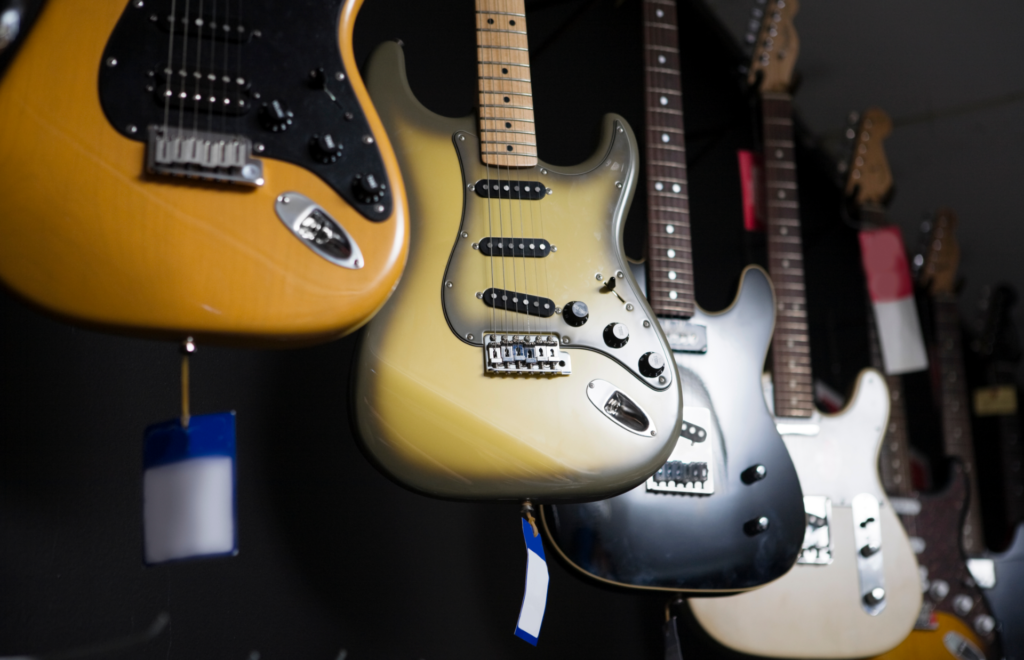The electric guitar, a versatile and iconic musical instrument, has played a significant role in shaping the modern musical landscape. B.B. From the soulful blues of King to the electrifying rock riffs of Jimi Hendrix, the electric guitar has left an indelible mark on the world of music. In this article, we will explore the intricacies of the electric guitar, its history, components, and its influence on various musical styles.
History:
The roots of the electric guitar can be traced to the early 20th century. In the 1920s and 1930s, as jazz and blues music gained popularity, musicians looked for ways to enhance the sound of their guitars to be heard in larger venues. This led to the invention of the first commercially successful electric guitar, the Rickenbacker “Frying Pan”, in 1931. Developed by George Beauchamp and Adolph Rickenbacker, this lap steel guitar had a magnetic pickup that converted string vibrations into electrical signals, allowing sound. To be amplified.
Components of Electric Guitar:
Body:
Electric guitar bodies are usually made of solid wood, although there are semi-hollow and hollow body designs. Common tone woods include mahogany, alder, and maple. Body shape and design can vary significantly between different guitar models, affecting both aesthetics and sound.
Neck:
The neck of an electric guitar is attached to the body and is often made of maple or mahogany. It features frets that divide the neck into intervals, allowing musicians to produce different tones. The neck also features a truss rod, a vital component that helps adjust the curvature of the neck to optimize playability.
Pick up:
Pickups are magnetic devices located on the body of the guitar beneath the strings. They pick up the vibrations of the wires and convert them into electrical signals. There are different types of pickups, such as single-coil and humbuckers, each offering different tonal characteristics.
Bridge:
The bridge connects the strings to the body and is essential for adjusting the sound and action of the guitar. Electric guitars can have different bridge designs, including fixed bridges, tremolo bridges, and more.

Control:
Electric guitars are equipped with control knobs and switches that allow musicians to manipulate the sound. Common controls include volume and tone knobs, pickup selector, and sometimes additional features such as coil-splitting for versatile tonal options.
Types of Electric guitars
From classic blues to shredding metal, a variety of electric guitars cater to a range of playing styles. This article aims to highlight the distinctive features of each type, providing a comprehensive guide for enthusiasts and aspiring musicians.
Stratocaster: The Versatile Workhorse
The Fender Stratocaster, or Strat, stands as the pinnacle of versatility. Introduced in the 1950s, its contoured body, three single-coil pickups and iconic double-cutaway design have made it a favourite across all genres. Renowned for its crisp, clean tone and fluid playability, the Stratocaster has graced stages around the world, played by legends like Jimi Hendrix and Eric Clapton.
Telecaster: the pioneer of solid body guitars
The Telecaster, Fender’s ground-breaking creation, pioneered the concept of the solid-body guitar. With a single-cutaway design, two single-coil pickups, and a no-nonsense approach, the Telecaster delivers a distinctively crisp sound. From country to rock, its simplicity and reliability have earned it an iconic status in the music industry.
Les Paul: The Epitome of Rock and Roll
Gibson’s Les Paul is an enduring icon of rock and roll. With a solid mahogany body, a carved maple top and powerful humbucker pickups, the Les Paul delivers a strong, thick tone. This guitar has left an indelible mark on the rock genre, with iconic players such as Jimmy Page and Slash adopting its unique sustain and rich sound.
SG: Attractive design, powerful sound
The Gibson SG, or Solid Guitar, boasts a sleek, double-cutaway design and light weight. Famous for its raw power and searing vocals, SG has been championed by rock and metal legends, including AC/DC’s Angus Young. Its aggressive aesthetic and high-reaching neck make it a favourite among players seeking a dynamic and expressive instrument.
Hollow Body: Jazz and Beyond
Hollow-body electric guitars, such as the Gibson ES-335, epitomize the spirit of jazz and blues. These guitars have a completely hollow body or semi-hollow structure, providing a warm, resonant tone. Jazz virtuosos such as Wes Montgomery embraced the hollow-body for its acoustic-like qualities, while blues players found its expressive character irresistible.
SuperStrat: Shredding and Speed
Emerging in the 1980s, the SuperStrat represents a modern evolution of the traditional Stratocaster. With hot-rodded features like humbucking pickups, locking tremolo system and slim neck profiles, Superstrats are engineered for speed and precision. Popularized by virtuosos like Eddie Van Halen, these guitar pieces are synonymous with the high-energy world of heavy metal.
Custom designs
In addition to mainstream models, electric guitars come in myriad custom and distinctive designs. Boutique builders and innovative manufacturers create equipment that caters to specific styles or unique player preferences. From extended-range guitars for metal to ergonomic designs for comfort, these specialized instruments add depth to the electric guitar landscape.
Influence on Music:
The electric guitar revolutionized the music industry by providing musicians with a powerful tool for self-expression. Its ability to produce a variety of tones, from clean and melodic to distorted and aggressive, has made it prominent in various musical genres.

Rock and roll:
The electric guitar became synonymous with the energy and rebellious spirit of rock and roll. Pioneering guitarists such as Chuck Berry and Elvis Presley’s guitarist Scotty Moore used this instrument to create iconic riffs that defined the genre.
Blues:
The expressive nature of the electric guitar found an ideal home in the blues. Muddy Waters and B.B. Legends like King used the instrument to express raw emotion and intimacy, influencing generations of musicians.
Jazz:
In the field of jazz, the electric guitar added a new dimension. Artists such as Charlie Christian and later Wes Montgomery demonstrated the guitar’s versatility, and contributed to the development of jazz music.
Heavy Metal:
The distorted tones and aggressive playing style of the electric guitar were found to be a natural fit into the heavy metal genre. Guitarists such as Jimi Hendrix, Jimmy Page, and later Eddie Van Halen pushed the boundaries of guitar playing, inspiring a new generation of metal musicians.
Conclusion:
The electric guitar is a symbol of musical innovation and creativity. Its evolution over the decades has shaped the course of popular music, allowing musicians to explore new sonic landscapes and push the boundaries of artistic expression. As technology advances, the electric guitar remains a dynamic and integral part of the ever-evolving world of music.
Also Read ADOBE PODCAST: A DETAILED EXPLORATION OF UNVEILING THE ART OF PODCASTING WITH ADOBE


Pingback: Coffee Machines 101: Brewing the Perfect Cup - Daily News Brief